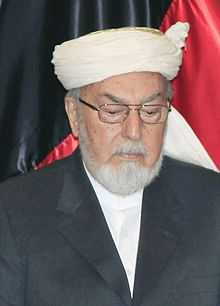Ahmed Gailani

Pir Sayyid Ahmed Gailani (born 1932), is the leader (Pir) of the Qadiriyyah Sufi order in Afghanistan, and the founder of the National Islamic Front of Afghanistan (Mahaz-i-Milli Islami ye Afghanistan), a party that was associated with the Mujahideen who led the war against the Soviet Union in the 1980s. He is an ethnic Pashtun.[1]
Sayyid Ahmed Gailani's family are descended from Abdul-Qadir Gilani, the founder of the Qadiriyyah.[2] His father, Sayyid Hasan Gailani, was born in Baghdad before moving to Afghanistan in 1905 in order to establish the Qadiriyyah order in that country.[3] Amir Habibullah Khan gave him land in Kabul and eastern Nangarhar Province.[4]
Ahmed Gailani was born in the Surkh-Rōd District of eastern Nangarhar Province of Afghanistan, where he remains a significant figure. He studied at Abu Hanifa College in Kabul, before graduating at the Faculty of Theology of Kabul University in 1960. In 1952, he reinforced his family's close ties to the Afghan royal family by marrying Adela, a granddaughter of Amir Habibullah.[5]
Prior to the war, Gailani invested more time in his business career than in the leadership of his Sufi tariqah, often travelling to France and England. Through his connection with the monarchy, he was able to obtain the Peugeot dealership in Kabul.[6]
In 1979, after the communist PDPA had come to power, Pir Gailani fled to Pakistan where he created the National Islamic Front of Afghanistan, a moderate royalist faction. This party was one of the seven used by the Pakistani ISI for distributing CIA-funded weapons to the mujahideen fighting the Soviet occupation. NIFA had the most liberal and secular stance of all the Peshawar parties, and it supported the return of King Zahir Shah from exile.[3] Representing the interests of the pre-war Pashtun establishment, it rejected both communism and Islamism, in favour of "nationalism and democracy."[6]
Gailani's constituency was drawn from the following of the Qadiryyah, and his group functioned like a Sufi order, greatly hampering its efficiency as a political and military organisation. The followers of the pir always expected to interact with him personally, which meant that the party functioned like a court, centered on Gailani and his children, rather than like a modern party. No decision was ever delegated. The quantity of weapons a NIFA mujahideen commander could expect to receive depended mostly on his personal relation with the pir. Also the pir's tradition of generosity led to many abuses, with many party officials receiving essentially fictitious posts through personal contacts.[7]
Despite this, NIFA remained the most popular party among the Afghan refugees living in Pakistan. A poll carried out in 1987 revealed that 456 refugees out of a sample of 2,000 supported NIFA, which was the highest score of any of the mujahideen parties.[8] By contrast, the Pakistanis, judging the group inefficient allocated NIFA only 10-11 percent of the weapons procured by the CIA, with a much larger share going to Islamist groups, in particular Hekmatyar's Hezb-e-Islami Gulbuddin.[9]
Outside of the ISI Gailani had few links with foreign patrons(unlike the Islamists who had ties in the Arab world), but he did receive some support from American conservative lobbying groups such as the Committee for a Free Afghanistan, an emanation of the Heritage Foundation, and Freedom House.[10] He was also associated with Lord Bethell of the London-based Radio Free Kabul.
In October 2001, Pir Ahmed Gailani headed a group of Afghan leaders, the Assembly for Peace and National Unity of Afghanistan, which attempted to win over moderate elements in the Taliban.[11]
Children
- Fatima Gailani, current president of the Afghan Red Crescent Society.[12]
- Sayed Hamed Gailani, First Deputy Speaker of Afghanistan’s Senate.[13]
- Maryam Gailani, founder of shamsa children's village and Adela Foundation
- Sayed Mohammed Gailani, former Afghan ambassador to the Hashemite Kingdom of Jordan
- Zahra Gailani, creator of zdsuzani
Further reading
- Borovik, Artyom (1990). The Hidden War: A Russian Journalist's Account of the Soviet War in Afghanistan. New York: Grove Press. pp. 141–147.
References
- ↑ http://fpc.state.gov/documents/organization/121930.pdf
- ↑ Edwards, David (2002). Before Taliban: Genealogies of the Afghan Jihad. Berkeley: University of California Press. p. 252. ISBN 978-0-520-22861-0.
- ↑ 3.0 3.1 Vogelsang, Willem (2002). The Afghans. Malden: Blackwell Publishers. p. 316. ISBN 978-0-631-19841-3.
- ↑ Edwards, p.255
- ↑ Dorronsoro, Gilles (2005). Revolution Unending. Afghanistan: 1979 to the present. London: Hurst. pp. 151–152. ISBN 1-85065-703-3.
- ↑ 6.0 6.1 Rubin, Barnett (1995). The fragmentation of Afghanistan. New Haven: Yale University Press. p. 203. ISBN 0-300-05963-9.
- ↑ Edwards, p.274
- ↑ Urban, Mark (1990). War in Afghanistan. London: Palgrave MacMillan. p. 223. ISBN 0-333-51477-7.
- ↑ Yousaf, Mohammad; Adkin, Mark (2001). Afghanistan: The Bear Trap. Havertown: Casemate. p. 105. ISBN 0-9711709-2-4.
- ↑ Rubin,p.210
- ↑ Lloyd Parry, Richard (12 October 2001). "Anti-Taliban warlords set the rules for a new round of the Great Game". The Independent. Retrieved 2010-06-08.
- ↑ "Fatima Gailani: "women and children are the first targets of war"". Red Cross/Red Crescent. 7 March 2007. Retrieved 2010-06-08.
- ↑ Coll, Steve (January 12, 2009). "Talking Afghan Politics". Archived from the original on 24 June 2010. Retrieved 2010-06-08.
- Afghanistan's Powerbrokers, BBC.com
External links
| Wikimedia Commons has media related to Ahmed Gailani. |